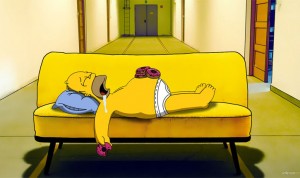Whether you believe in God and an afterlife or not, we all can agree that we all have thought the same thing. What happens to us after we die? Do we cease to exist, our minds and the person who we were in life completely gone forever, or do we go someplace else? Throughout history, we have answered this question with varying degrees. Hindu’s and Buddhists believe in reincarnation, Catholics believe Heaven, and a lot of Greek and Native American had some form of afterlife. Here’s what most major religions believe in when it comes to the afterlife: http://www.religiousmovements.org/views-on-death-according-to-different-religions/. Regardless, we all agree on one thing: at some time in our lives, we all will die.
The thing that makes this topic so interesting is that there is absolutely no way of figuring this out. Much like the topic in class earlier this year asking if prayer heals, we cannot come up with a way to actually determine what happens to us in the afterlife with the certainty we usually can in regards to scientific findings. If you look hard enough, you can find hundreds or even thousands of people online saying they saw many different things after they died and were revived. Seeing all of these “near death experiences”, we would have to scientifically conclude that there might be something in the afterlife. You can argue whether this may file drawer problem, as those who don’t see anything and come back simply may not say anything about it (why would they if they didn’t see anything?). Still, with all of these people seeing things, I want to look at some ways scientists have gone about trying to answer this question in the past. (Note, there will be no way I can answer this question in this blog, nor should I. Take what I say with a grain of salt and know I’m looking at the process, not a solution. You can argue you can’t truly get the full picture without fully dying, but I’m trying to find the best solutions science can come up with).
This should really go without saying, but it’s far easier to die and see what happens in the afterlife than to report it back when you might be brought back to life. If (and that’s a big if) you’re brought back to life, you may have no memory of what you experienced when you died, either forgetting it entirely or just losing good portions of the memory. You can associate that with not remembering what you dreamed about when you woke up.
After looking through the internet for quite some time (there were many articles on the matter, just none very trustworthy), I came across an article issued in November 0f 2006 in New Scientist that looked for the answer to my question. You may need your PSU credentials to see this study, as I did. This study used a variety of different studies, but mostly had three different ways of finding an afterlife. They are as follows:
1.) A researcher creates an unbreakable riddle, one only he/she could solve. After they die, people on Earth find a way to contact them in the afterlife, getting the key to solve said riddle and answering the question. If they can’t find the key, there is no afterlife or no way to contact the dead that we know of yet.
2.) Looking at near death experiences, we can see what the person experienced and base that off of real life events they couldn’t have seen or possibly know when they were alive.
3.) People are weighed before, during, and after their death. If there is a “soul”, then this should be shown with a decrease, however small, in their weight as they die as their soul leaves their body.
Looking at the first way scientists look at how to scientifically prove their’s a life after death, this seems to be the least likely. Not only do we not have any feasible ways of communicating in the dead that is proven, we also don’t know if we remember anything in the afterlife from our previous life. For example, the article focuses mainly on how psychologist Robert Thouless did so in 1984, where he then died. However, no one has been able to crack the code since, even after many have said they contacted Thouless and got the correct key. One person even said they were able to contact him multiple times, but he doesn’t remember the password. You can either say he lied and did not contact Thouless or that Thouless had no reccollection of his previous life. Therefore, we can assert that this isn’t a good strategy for finding life after death.
The second strategy mentioned above is one I mentioned in the opening paragraphs-asking people what they saw when they died and were brought back. Like mentioned above, you can’t ethically kill people and then bring them back, so to combat this they put a TV on the ceiling above an operating room, which changes between images and is not visible to anyone who wouldn’t be looking overhead. The problem with this strategy is that not only do you rely on patients dying, coming back, and remembering this image, you also are relying on the idea that the soul moves upward after death, which may not even be what happens. As this article was posted in 2006, they have yet to find anyone who has been able to identify the images. This may be a great option in the future, but I think a better method needs to be established.
Finally, the third option is where we turn our attention to. Of the three, I think this is the method that is the best rooted in science. In regards to the other two, you can see that there is a lot of things you cannot control, like speaking to the dead or bringing someone who has had their heart stopped back. In this, however, it’s quite simple. You continuously weigh someone as they’re dying, and see if they lose weight after they have died. You can attribute this weight loss to that being your soul, even micro-weight differences. However, this proved to be far harder than it may seem. A man by the name Duncan MacDougall tried this method all the way back in 1901. However, with outside factors he was unable to get a consistent measurement in weight. He concluded the weight of the soul was 20 grams, but this wasn’t supported by more evidence and concluded to be an anecdote. When this study was replicated, they were unable to find a difference in weight. However, this doesn’t prove that there wasn’t a drop in weight after death, the soul could just weigh far less than a scale can measure. Therefore, you would need very expensive technology to truly get an idea of the weight of the soul (if it does exist).
So, in conclusion, we have yet to find a good method for finding if there’s life after death. All of these methods had positives and negatives, and the latter two can be refined and tried again. But something the article does bring up is something that made me think. According to the First Law of Thermodynamics, energy is not lost or gained in the universe. Instead, it simply transfers. So, at the most basic level, there is more for us after death. Whether our energy goes towards a small particle or part of a new animal, we will become something after death. Finally, while we cannot scientifically prove that there is life after death, that doesn’t mean that we have to stop believing in it. And who knows, we may be able to figure this out in the future with new technology or scientific findings!




 Now that the background on what diabetes is covered, the question then becomes, why is obesity increasing in america and is it correlated to diabetes? My first answer to this question was because kids are lazy. As Americans, our family traditions drastically differ from other countries. Our traditions have also greatly changed over a short period of time. The common belief that women stay home to be the rock of the household isn’t the norm anymore. Most children are lock-key kids, who let themselves into the house after school, make themselves an unhealthy snack, and wait until their parents get home from work. Looking at this simple change, it’s no surprise that children are becoming lazy, and no surprise again, lazy is the number one cause of obesity.
Now that the background on what diabetes is covered, the question then becomes, why is obesity increasing in america and is it correlated to diabetes? My first answer to this question was because kids are lazy. As Americans, our family traditions drastically differ from other countries. Our traditions have also greatly changed over a short period of time. The common belief that women stay home to be the rock of the household isn’t the norm anymore. Most children are lock-key kids, who let themselves into the house after school, make themselves an unhealthy snack, and wait until their parents get home from work. Looking at this simple change, it’s no surprise that children are becoming lazy, and no surprise again, lazy is the number one cause of obesity.


 or concern could be answered and validated within milliseconds. Contrary to that, the tall tale saying the sun is bad for our skin has been passed down generations by word of mouth. We’ve been told to cover up in the sun at the risk of getting skin cancer without any concrete proof. Now, with multiple experiments and evidence to support this theory, the internet would agree with the statement that the sun is harmful to our skin, but has new evidence about what the sun is doing to the inside of our bodies.
or concern could be answered and validated within milliseconds. Contrary to that, the tall tale saying the sun is bad for our skin has been passed down generations by word of mouth. We’ve been told to cover up in the sun at the risk of getting skin cancer without any concrete proof. Now, with multiple experiments and evidence to support this theory, the internet would agree with the statement that the sun is harmful to our skin, but has new evidence about what the sun is doing to the inside of our bodies. spots on the body. Evidence in this statement is found
spots on the body. Evidence in this statement is found